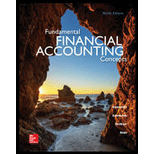
a.
Prepare the income statement, statement of changes in stockholders’ equity, Period-end-
a.
Explanation of Solution
Income statement:
Income statement is the financial statement of a company which shows all the revenues earned and expenses incurred by the company over a period of time.
Statement of changes in stockholders' equity:
Statement of changes in stockholders' equity records the changes in the owners’ equity during the end of an accounting period by explaining about the increase or decrease in the capital reserves of shares.
Balance sheet:
Balance is the financial statement that reports a company’s resources (assets) and claims of creditors (liabilities) and stockholders (stockholders’ equity) over those resources. The resources of the company are assets which include money contributed by stockholders and creditors. Hence, the main elements of the balance sheet are assets, liabilities, and stockholders’ equity.
Statement of cash flows:
Statement of cash flows is one among the financial statement of a Company that shows aggregate data of all
Prepare 2016 income statement of Corporation P:
| Corporation P | |
| Income Statement | |
| For the Year Ended December 31, 2016 | |
| Particulars | Amount |
| Revenue | $35,550 |
| Less: Expenses | $26,000 |
| Net income | $9,550 |
Table (1)
Working notes:
Calculate (sales) revenue.
Calculate net income.
Calculate ending
Prepare the 2016 statement of changes in stockholders’ equity of Corporation P:
| Corporation P | ||
| Statement of Changes in Stockholders' Equity | ||
| For the year Ended December 31, 2016 | ||
| Particulars | Amount | Amount |
| Opening common stock | $13,000 | |
| Add: Issuance of common stock | $4,000 | |
| Ending Common stock | $17,000 | |
| Opening retained earnings | $5,000 | |
| Add: Net income | $9,550 | |
| Less: cash dividend | ($2,000) | |
| Ending retained earnings | $12,550 | |
| Total stockholders' equity | $29,550 | |
Table (2)
Working note:
Calculate Opening common stock.
Prepare the 2016 balance sheet of Corporation P:
| Corporation P | ||
| Balance Sheet | ||
| For the year Ended December 31, 2016 | ||
| Amount | Amount | |
| Assets: | ||
| Assets | $38,550 | |
| Liabilities | $9,000 | |
| Stockholders' Equity: | ||
| Common stock | $17,000 | |
| Retained earnings | $12,550 | |
| Total stockholders' equity | $29,550 | |
| Total liabilities and Stockholders' equity | $38,550 | |
Table (3)
Working notes:
Calculate total assets.
Calculate total liabilities.
Prepare the 2016 statement of cash flows of Corporation P:
| Corporation P | ||
| Statement of Cash Flows | ||
| For the year Ended December 31, 2016 | ||
| Particulars | Amount | Amount |
| Cash flow from operating Activities: | ||
| Cash receipt from revenue | $35,550 | |
| Less: Cash payment for expense | ($26,000) | |
| Net cash flow from operating activates | $9,550 | |
| Cash flow from Investing Activities: | ||
| Net cash flow from investing activities | $0 | |
| Cash flow from Financing Activities: | ||
| Cash receipts from issuance of stock | $4,000 | |
| Cash payment to creditors | ($3,000) | |
| Cash dividend paid to stockholders | ($2,000) | |
| Net cash flow from financing activities | ($1,000) | |
| Net increase in cash | $8,550 | |
| Add: Opening cash balance | $30,000 | |
| Ending cash balance | $38,550 | |
Table (4)
b.
Determine the percentage of total assets that were provided by creditors, investors and earnings of Corporation P.
b.
Explanation of Solution
Debt to Asset Ratio:
Debt to asset ratio is the ratio that measures the difference between total asset and total liability of the company. Debt ratio reflects the finance strategy of the company. It is used to evaluate company’s ability to pay its debts. Higher debt ratio implies the higher financial risk.
Calculate the percentage of assets acquired from creditors of Corporation P:
Stockholders’ equity to asset ratio:
Stockholders ‘equity to asset ratio is the ratio that measures the difference between total asset and stockholders ‘equity of the company. Stockholders’ equity ratio reflects the amount of assets that can be claimed by the stockholders in proportion to the value of shares owned by them.
Calculate percentage of total assets acquired from investors of Corporation P:
Retained earnings:
Retained earnings are the portion of earnings kept by the business for the purpose of reinvestments, payment of debts, or for future growth.
Calculate percentage of total assets acquired from retained earnings of Corporation P:
c.
Ascertain the balance in the revenue, expenses, and dividends accounts of January1, 2017.
c.
Explanation of Solution
The balances of the temporary accounts, revenue, expenses and dividends will be zero on January 1, 2017, because they were closed to Retained Earnings at December 31, 2016.
Want to see more full solutions like this?
Chapter 1 Solutions
Fundamental Financial Accounting Concepts, 9th Edition

 AccountingAccountingISBN:9781337272094Author:WARREN, Carl S., Reeve, James M., Duchac, Jonathan E.Publisher:Cengage Learning,
AccountingAccountingISBN:9781337272094Author:WARREN, Carl S., Reeve, James M., Duchac, Jonathan E.Publisher:Cengage Learning, Accounting Information SystemsAccountingISBN:9781337619202Author:Hall, James A.Publisher:Cengage Learning,
Accounting Information SystemsAccountingISBN:9781337619202Author:Hall, James A.Publisher:Cengage Learning, Horngren's Cost Accounting: A Managerial Emphasis...AccountingISBN:9780134475585Author:Srikant M. Datar, Madhav V. RajanPublisher:PEARSON
Horngren's Cost Accounting: A Managerial Emphasis...AccountingISBN:9780134475585Author:Srikant M. Datar, Madhav V. RajanPublisher:PEARSON Intermediate AccountingAccountingISBN:9781259722660Author:J. David Spiceland, Mark W. Nelson, Wayne M ThomasPublisher:McGraw-Hill Education
Intermediate AccountingAccountingISBN:9781259722660Author:J. David Spiceland, Mark W. Nelson, Wayne M ThomasPublisher:McGraw-Hill Education Financial and Managerial AccountingAccountingISBN:9781259726705Author:John J Wild, Ken W. Shaw, Barbara Chiappetta Fundamental Accounting PrinciplesPublisher:McGraw-Hill Education
Financial and Managerial AccountingAccountingISBN:9781259726705Author:John J Wild, Ken W. Shaw, Barbara Chiappetta Fundamental Accounting PrinciplesPublisher:McGraw-Hill Education





